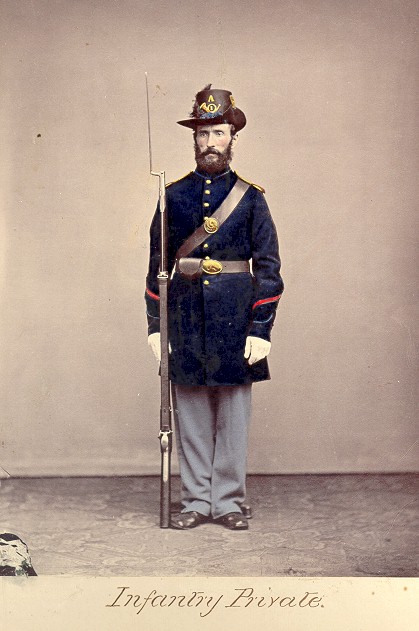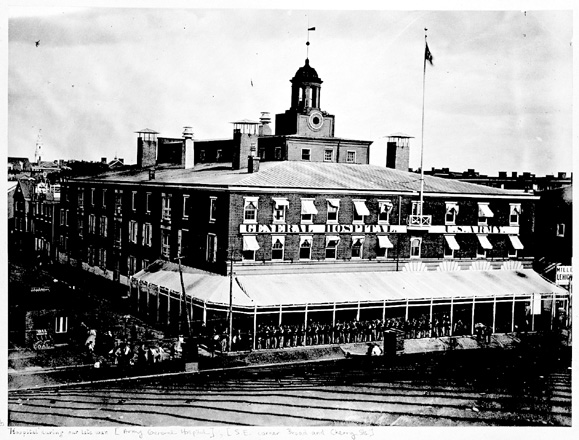Robert Ellingsworth, Civil War Soldier
 U.S. Infantry Private Uniform
U.S. Infantry Private Uniform
Robert Ellingsworth died as a result of a Confederate bullet, but that’s getting ahead of ourselves.
Robert was born about 1811 in Essex County, Delaware. At some point, he moved into Pennsylvania. Robert married Rebecca Betterton on October 6, 1833 in the Third Presbyterian Church in Philadelphia. She was born around 1815.
Robert was living in Lower Marion Township, Pennsylvania in 1840. The household consisted of “one male, age 20-under 30; one male, under 5; one female, age 20-under 30; one female, age 5-under 10”. In 1850, the family, living in Kensington, West Philadelphia, was as follows:
- Robert, age 39, laborer
- Rebecca, age 30, his wife
- Mary Ann, age 15, daughter
- Robert, age 13, son
- Samuel, age 10, son
- Joseph, age 6, son
- William, age 3, son
- Thomas, age 4/12, son
In January of 1861, when Abraham Lincoln, a known opponent of slavery, was elected president, the South Carolina legislature perceived a threat. Calling a state convention, the delegates voted to remove the state of South Carolina from the union known as the United States of America. The secession of South Carolina was followed by the secession of six more states — Mississippi, Florida, Alabama, Georgia, Louisiana, and Texas — and the threat of secession by four more — Virginia, Arkansas, Tennessee, and North Carolina. These eleven states eventually formed the Confederate States of America. In February, the South started to seize federal forts, and in April, when Lincoln wanted to send supplies to Fort Sumter and was refused, shots were fired on the fort and the Civil War began.
Robert was 43 years old when he decided to volunteer to join the Union Army. He enlisted as a Private on August 20, 1861 in Philadelphia. A force was being recruited there under Edward Gregory, and in October, this force was consolidated with another. They rendezvoused at Camp Chase, at Gray’s Ferry on the Schuylkill, and mustered into service, for a three-year stint, on December 4 as the 91st Infantry Regiment Pennsylvania. Robert was assigned to Company E. He was listed as 5’7’ tall, with dark hair and brown eyes, and a dark complexion. His occupation was listed as a butcher.
On Wednesday afternoon, December 11, a large crowd gathered at the encampment to witness the ceremony of the presentation of colors to the 91st Regiment. The Philadelphia Inquirer reported “this fine regiment is now on the eve of departure for the seat of war.”
The Battles Begin
On the 21st of January 1862, the regiment was ordered to Washington D.C. and camped three miles from the city. On February 28, Company E was ordered to patrol and guard the Capitol. The 91st remained here until April 2, when it was moved to Alexandria. From September 15 through October, Robert was detailed as the brigade butcher. He returned to his normal duties in November. The 91st saw its first battle on December 13, 1862 at Fredericksburg, VA. On it’s maiden battle, the regiment charged gallantly, but lost two officers and 87 men. This regiment would fight in over 40 battles against the Confederate soldiers.
Gettysburg, PA
The 91st began its march towards Gettysburg on June 9, 1863. The weather was very hot, the men suffering much on the way, as many of them were shoeless. It arrived in Hanover, Pennsylvania on July 1. They expected to stay for the night, but all they had time for was coffee and dinner, when at 8 p.m. they were ordered into line and marched rapidly toward the battlefield. About midnight the column was halted and lay down in the road to rest as best as they could (they had marched over 20 miles that day). At 4 a.m. they resumed their march and arrived at Gettysburg at 8 a.m. The immediately moved into line to support the center of the Union Line. At 2 p.m., they just had time for coffee when they were ordered to move “double-quick” to Little Round Top, 1-½ miles away. It is a rocky hill on the southern end of Cemetery Ridge, and offered an unobstructed view of the battlefield to the north and west. It is said that there is no part of the battlefield of Gettysburg more important than Little Round Top. It was the heart of the battlefield, the key to the victory, the unofficial High water mark. The struggle for the possession of Little Round Top may be the most misunderstood battle of the whole war. If the Confederates had captured it during the second day of battle there would have been no third day, no Pickett’s charge, no victory at Gettysburg, no High Water mark, maybe no Union.
The regiment marched up one side as the rebels charged up the other, and was thrown into line to meet them. They continued to advance the slope, engaging and pushing the Confederates, but were being picked off by sharpshooters occupying Devil’s Den. They were helped by 140th New York regiment.
During the night, under the cover of darkness and out of sight of the sharpshooters, the job of retrieving the wounded in front of their position took place (it took nearly two hours) and the 91st built a stone wall about halfway down the slope for protection.
The next morning, July 3, they remained in position. All was quiet until the sharpshooters returned at 8 a.m. It rained most of the day, and at 1 p.m., a signal cannon was fired that started the Confederate artillery to begin its barrage that preceded Pickett’s charge. This failed attempt by the rebels prompted Robert E. Lee to gather his men and call for a retreat. As the heavy rain fell, the 91st joined in the pursuit of Lee’s fleeing army. Skirmishes continued and some rebel prisoners were taken. On the 5th the regiment stopped to camp at Marsh Field, which was a field of mud.
Of the 20 officers and 205 enlisted men of the 91st, 3 were killed and 16 wounded at Gettysburg.
Next Battles
Through the Fall Campaign of 1863, in the valley of Virginia, there was constant enemy contact and activity. The regiment was finally assigned to duty along the line of the Rappahannock River and the Orange & Alexandria Railroad. The 91st was mustered out of duty on Christmas Day, December 25th at Bealton, Virginia. Those who wanted to reenlist, and a large proportion of them did, were mustered in for an additional term of three years the following day, December 26th.
The 91st was given a much-needed furlough on January 2, 1864. Upon its arrival in Philadelphia, it paraded down Chestnut Street, in front of Independence Hall. The regiment reassembled on February 16 at Chester, PA, with some fresh recruits, and left for Washington DC.
Entering into the Spring Campaign on May 4, 1864, the battles became more frequent. The most costly for Robert Ellingsworth was Petersburg, Virginia.
Petersburg, VA
On June 16, 1864, the regiment reached and crossed the James River, and moved up in front of Petersburg. At daybreak on the 18th the regiment moved down the first line of rebel works and was placed in the rear of the battle line. Order was given to charge across and capture the Suffolk & Petersburg Railroad. Advancing double-quick the enemy was driven to its next line of works. For over four hours the battle went on. At dusk, they were ordered to charge the enemy occupying a hill. The position was carried and a line of works was thrown up. In these two engagements the regiment lost eighty-two wounded or killed. It was in this battle that Robert was shot in the thigh as he charged the enemy works.
[The battle at Petersburg lasted until July 3, when veterans and recruits from the 62nd PA were transferred to the 91st, as its ranks were sadly depleted during this campaign. The regiment went on to fight for another year, finally mustered out on July 10, 1865 in Alexandria, VA and reached Philadelphia July 12. The 91st fought in over 20 battles, losing 108 men killed or dying from wounds received in battle, 86 men dying from disease, 341 wounded, and 69 men captured or missing.]
Robert was brought to the Army General Hospital in Alexandria, Virginia for treatment. He stayed there until July 11th, when he was transferred to another military hospital, the U.S. General Hospital at Broad & Cherry Streets in Philadelphia. Robert succumbed to his wound on September 22, 1864. The cause of death was listed as “Exhaustion after Gun Shot wound.” His body was taken by his relatives for his funeral. On September 24th the U.S. military delivered to his wife Rebecca “two caps, one dress coat, one jacket, one pair of pants, one pair of shoes and the money that was in Robert’s pocketbook & 61 cents.” He was to be buried with military honors. A notice appeared in the Philadelphia Public Ledger newspaper on September 24 inviting “his relatives and friends to attend his funeral on Tuesday afternoon, the 27th at 2 o’clock from the residence of his brother-in-law, Samuel M. Crap, 735 Federal Street.” He was interred in the Union M.E. Burial Ground on 10th Street.

U.S. Army General Hospital – Philadelphia
On October 5, 1864, Rebecca filed an application to receive his Civil War widow’s pension. She was granted $8.00 per month, commencing on September 22, 1864.
Article written and provided by Gay Raab.